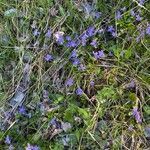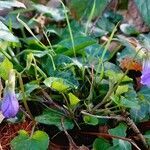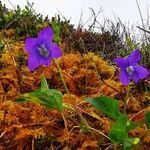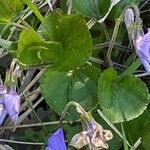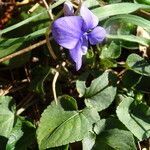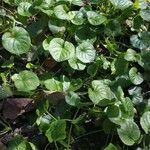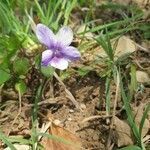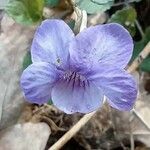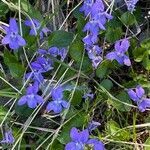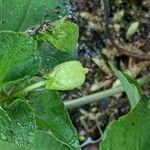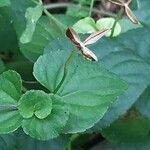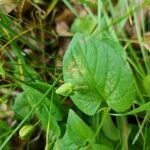Rhizomatous perennial; stems prostrate to ascending, glabrous, 5-20 cm long. Lvs all similar, with fine hairs near margin above, (7)-15-25 × (7)-15-25 mm, ovate-cordate, subacute to acuminate, with > 10 shallow crenations each side; stipules linear, acute, 5-10 × 1-(2) mm, long-fimbriate; fimbriae 1-1.5 mm long; petiole glabrous, (3)-15-40 mm long. Peduncles erect, with very fine hairs above; bracts linear, with 1-4 fimbriae near base or entire, 3-6 mm long. Fls 15-20 mm diam. Sepals narrowly ovate-acuminate, 4-6 mm long; appendages 1-2 mm long. Petals blue-violet, > sepals, the lateral bearded; spur broad, 5-6 mm long, > sepal appendages. Style weakly geniculate at base, 2 mm long; stigma beaked. Capsule ellipsoid, glabrous, 9-12 mm long. Seeds obovoid, yellowish brown, 2 mm long.
Perennial herb, glabrous or ± pubescent, with decumbent branches 2–20 cm long arising from a short, erect stem bearing a cluster of leaves. Leaves with lamina ovate-orbicular, 5–45 mm long, apex obtuse or shortly acuminate, margins crenate, base cordate; petiole 1–3.5 cm long, glabrous; stipules lanceolate, fimbriate, connate at base. Flower-scapes 2.5–6 cm long, glabrous; bracteoles above middle. Sepals lanceolate with acute apex to narrowly triangular with a subulate apex, 7–12 mm long; appendages large, accrescent in fruit. Petals c. 10 mm long, blue-violet; anterior petal with spur c. 5 mm long, notched at obtuse apex. Capsule ovoid, 7–10 mm long, glabrous. Seeds ovoid, c. 2 mm long, yellowish brown.
A perennial plant. It grows 10-20 cm high and 25-40 cm wide. The leaves are heart-shaped. The flowers are purple-blue and without a scent.
